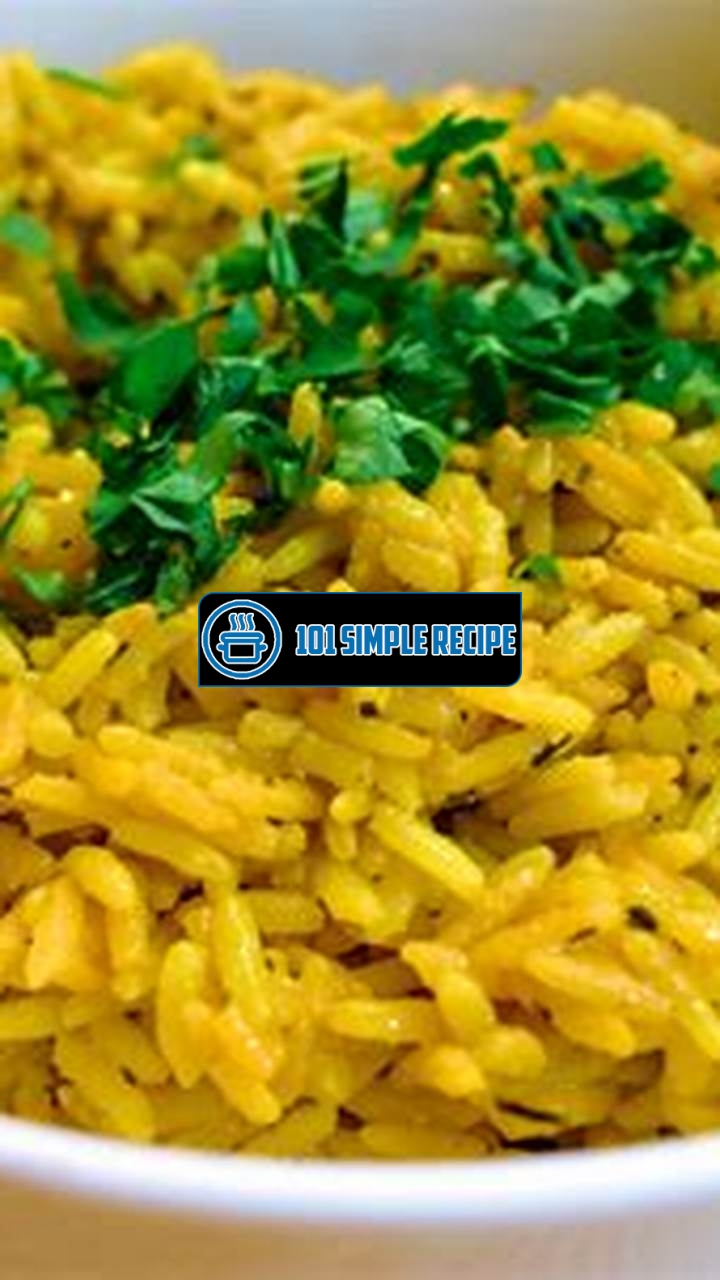Are you ready to discover the secret ingredients that make delicious yellow rice so irresistible? Look no further! In this article, we will uncover the key elements that bring out the vibrant color, rich flavor, and enticing aroma in every grain of this beloved dish. Whether you’re a cooking enthusiast or simply appreciate a tasty plate of rice, you’ll find this exploration into the world of yellow rice truly fascinating. So, let’s delve into the wonderful realm of flavors and spices that make yellow rice a gastronomic delight!

What is Yellow Rice?
Yellow rice is a beloved and scrumptious dish that has its origins in various regions across the globe. This flavorful dish is renowned for its vibrant yellow color and delightful taste. It is typically made by cooking rice with an assortment of ingredients that infuse it with a burst of flavors. Whether you enjoy it as a side dish or as a main course, yellow rice never fails to satisfy your taste buds.
The History of Yellow Rice
Yellow rice has a rich history that dates back centuries. It is believed to have originated in regions such as India, Spain, and Indonesia. In India, yellow rice is an integral part of traditional cuisine and is often prepared during festive occasions. The use of turmeric, a key ingredient that gives yellow rice its distinctive color, can be traced back to ancient times in India. This spice not only adds color but also imparts a unique flavor to the rice.
In Spain, yellow rice, also known as arroz amarillo, is a popular dish that is commonly prepared using saffron. Saffron, a prized spice, is known for its vibrant yellow color and delicate aroma. It is used to infuse the rice with its characteristic golden hue. Yellow rice is often served alongside dishes such as paella, adding a burst of flavor and visual appeal to the meal.
Indonesia also boasts its own version of yellow rice, known as nasi kuning. This traditional dish is often prepared for special occasions and celebrations. It is made by cooking rice with turmeric, coconut milk, and various spices, resulting in a fragrant and visually stunning dish.
The Flavor Profile of Yellow Rice
Yellow rice is known for its delectable flavor profile that combines a variety of aromatic spices. The primary spice used to achieve the vibrant yellow color is turmeric. Turmeric adds a warm and slightly bitter flavor to the rice, enhancing its overall taste.
In addition to turmeric, yellow rice often incorporates other spices such as cumin, coriander, and cinnamon. These spices contribute to the complexity of flavors, creating a harmonious blend that is both savory and fragrant. The use of garlic and onions further enhances the taste of yellow rice, providing a subtle yet satisfying undertone.
The Cultural Significance of Yellow Rice
Yellow rice holds great cultural significance in many regions around the world. In India, it is often associated with celebrations, festivals, and special occasions. It is considered an auspicious dish and is commonly served as part of religious rituals and feasts. Yellow rice symbolizes prosperity, happiness, and good fortune.
In Spain, yellow rice is a staple of Spanish cuisine, particularly in the region of Valencia. It is deeply ingrained in the country’s culinary traditions and is often enjoyed during family gatherings and festive events. The golden hue of the rice is reminiscent of the sun-soaked landscapes of Spain, making it a vibrant and cherished dish.
In Indonesia, yellow rice plays a significant role in various cultural ceremonies and traditions. It is often served during weddings, birthdays, and other important events. The bright yellow color represents prosperity and is believed to bring blessings to those who partake in the dish.
Overall, yellow rice is more than just a delicious dish; it is a symbol of tradition, celebration, and cultural identity in many parts of the world. Its vibrant color, tantalizing flavor profile, and cultural significance make it a truly special culinary delight.
The Essential Ingredient: Saffron
Uncover the secrets behind saffron, the key ingredient that gives yellow rice its distinct color and flavor.
The Origins of Saffron
Saffron is a prized spice known for its vibrant yellow color and unique flavor. It is derived from the crocus flower, specifically the Crocus sativus plant. This flower is native to the Mediterranean region and has been cultivated for thousands of years. Saffron has a long history and has been used in various cultures for its medicinal and culinary purposes.
Legend has it that saffron was first discovered by a young man named Crocus. As the story goes, he stumbled upon a beautiful maiden named Smilax, who transformed into a crocus flower. The young man named the flower after the maiden and thus, the Crocus sativus plant came into existence.
Historically, saffron has been highly valued and used by ancient civilizations such as the Egyptians, Greeks, and Romans. It was considered a luxury spice and was often used as an offering to the gods. Saffron was also highly prized for its medicinal properties, believed to treat various ailments including digestive issues, insomnia, and even depression.
Today, saffron is mainly cultivated in countries such as Iran, Spain, and India. These regions provide the ideal climate and conditions for the crocus flowers to thrive and produce high-quality saffron.
The Harvesting and Production of Saffron
The process of harvesting saffron is labor-intensive and requires careful attention to detail. The crocus flowers bloom for only a short period of time, usually in the autumn. During this time, skilled workers carefully pluck the delicate petals by hand, ensuring that only the red stigmas are collected.
Each flower produces only a small amount of saffron, approximately three stigmas, which are commonly referred to as saffron threads. These threads are then carefully dried to preserve their color, flavor, and aroma.
The production of saffron is a meticulous process that involves a great deal of patience and expertise. From the cultivation of the crocus flowers to the delicate hand-picking of the stigmas, each step is crucial in maintaining the quality and integrity of the saffron.
The Culinary Uses of Saffron
Saffron is known for its distinct flavor and aroma, which adds a unique dimension to various dishes. It is commonly used in both sweet and savory recipes.
In savory dishes, saffron is often used in rice dishes, such as the popular Spanish paella or the Persian dish known as saffron chicken with rice. It can also be found in creamy sauces, soups, and stews, adding depth and complexity to the flavors.
Saffron is also widely used in desserts and baked goods. It is a key ingredient in traditional dishes like Indian kheer (rice pudding) and French saffron buns. Its delicate flavor pairs well with ingredients like warm spices, citrus fruits, and nuts.
In conclusion, saffron is the essential ingredient that gives yellow rice its distinct color and flavor. Its origins can be traced back to ancient civilizations, and its harvesting and production require great care and expertise. In culinary applications, saffron adds a unique and delightful taste to both savory and sweet dishes, making it a truly versatile spice.
Other Flavorful Additions
When it comes to making delicious yellow rice, there are a few key ingredients that can take your dish to the next level. These complementary additions not only enhance the taste and aroma of the rice but also add a burst of flavor that will leave your taste buds begging for more. Let’s explore these secret ingredients and find out how they can elevate your yellow rice to new heights!
Turmeric: Nature’s Golden Spice
One of the essential ingredients in yellow rice is turmeric. This bright yellow spice not only gives the rice its signature hue but also adds a unique earthy flavor. Turmeric is known for its antioxidant properties and has been used for centuries in traditional medicine. It not only gives the rice a vibrant color but also imparts a subtle bitterness that pairs perfectly with the other flavors in the dish.
Fun Fact: Turmeric has been used for centuries in Ayurvedic medicine and is believed to have numerous health benefits, including reducing inflammation and boosting cognitive function.
Onions and Garlic: Savory Alliums
Onions and garlic are two essential ingredients that add depth and richness to yellow rice. These savory alliums bring a pungent and slightly sweet flavor to the dish. When sautéed until golden brown, onions develop a caramelized sweetness, while garlic adds a fragrant aroma.
Pro Tip: For a milder flavor, you can use shallots instead of onions. Shallots have a delicate taste that complements the other ingredients in yellow rice.
Seasoning with Herbs and Spices
Aside from turmeric, onions, and garlic, yellow rice can be enhanced with the addition of various herbs and spices. The right combination can elevate the dish to a whole new level of deliciousness. Some popular choices include cumin, paprika, cinnamon, and bay leaves.
Herbal Twist: Adding fresh herbs like cilantro, parsley, or basil at the end of cooking can give your yellow rice a burst of freshness and a vibrant green color.
Spice it Up: If you prefer a spicier version of yellow rice, you can add chili powder or cayenne pepper to give it a kick!
In conclusion, the secret to making delicious yellow rice lies in the carefully selected ingredients that enhance its flavor and aroma. Turmeric, onions, garlic, and a variety of herbs and spices come together to create a dish that is both visually appealing and incredibly tasty. So, the next time you whip up a batch of yellow rice, don’t forget to add these secret ingredients to take it from ordinary to extraordinary!
Building the Perfect Base
When it comes to yellow rice, there are key ingredients that contribute to its mouthwatering flavor and vibrant color. Let’s delve into the components that form the foundation of this beloved dish, each adding its unique characteristics.
Long-Grain Rice: The Preferred Variety
Long-grain rice is the go-to variety when it comes to making yellow rice. This type of rice has slender grains that remain separate and fluffy after cooking, making it ideal for this dish. Its neutral flavor acts as a canvas to absorb the flavors of other ingredients, resulting in a rich and aromatic final product. Long-grain rice provides the perfect base for creating a hearty and satisfying yellow rice dish.
Broth or Water: Infusing Flavor
The choice between using broth or water as the cooking liquid plays a crucial role in determining the overall flavor of yellow rice. While water is the simplest option, adding a flavorful broth elevates the taste profile of the dish. Chicken or vegetable broth brings a savory and aromatic element to the rice, infusing it with a depth of flavor that enhances every bite. Remember, the quality of the broth directly impacts the taste, so opt for a high-quality option or prepare your own homemade version for the best results.
Oil and Butter: Creating Texture
To achieve the perfect texture in yellow rice, a combination of oil and butter is commonly used. This duo adds richness and a velvety mouthfeel to the dish. The oil helps coat the rice grains, preventing them from sticking together while they cook. On the other hand, butter brings a luxurious and indulgent taste to the rice. The combination of these fats ensures that each spoonful of yellow rice is light, fluffy, and packed with flavor.
Note: For an extra burst of flavor, you can also consider adding various spices and seasonings to your yellow rice. Some popular options include turmeric, cumin, saffron, and paprika. Experimenting with different spices can take your yellow rice to a whole new level of deliciousness!
So, next time you’re preparing yellow rice, keep in mind the secret ingredients that form its foundation. The long-grain rice, flavorful broth or water, and the combination of oil and butter are the key elements that contribute to its delightful taste and texture. With these components in your culinary arsenal, you’ll be able to create a mouthwatering yellow rice dish that will impress your family and friends. Happy cooking! ️
Secrets to Achieving Fluffy Yellow Rice
When it comes to cooking yellow rice, achieving a perfectly cooked and fluffy texture can sometimes be a challenge. However, by mastering a few key techniques and following some helpful tips, you can easily create delicious, fluffy yellow rice every time. In this article, we will uncover the secrets that will elevate your yellow rice game to the next level.
Proper Rice Washing and Soaking
One of the essential steps in preparing fluffy yellow rice is proper rice washing and soaking. To start, measure the desired amount of rice and rinse it under cold water until the water runs clear. This helps to remove excess starch and any impurities that may affect the texture of the rice. After rinsing, allow the rice to soak in water for at least 30 minutes before cooking.
Tip: Soaking the rice helps to soften the grains and ensures even cooking.
Optimal Rice-to-Liquid Ratio
Getting the rice-to-liquid ratio right is another crucial element in achieving fluffy yellow rice. The general rule of thumb is to use a 1:1.5 ratio, meaning for every cup of rice, you should add one and a half cups of liquid. The liquid can be water or broth, depending on your preference.
Tip: Experiment with different liquids like chicken broth or coconut milk to enhance the flavor of your yellow rice.
Steaming vs. Stovetop Cooking
There are two primary methods for cooking yellow rice: steaming and stovetop cooking. Both techniques can yield excellent results, but they differ in their approach.
Steaming the rice involves using a rice cooker or a pot with a tight-fitting lid. After rinsing and soaking the rice, add it to the rice cooker or pot along with the appropriate amount of liquid. Cook the rice according to the manufacturer’s instructions or until all the liquid has been absorbed, and the rice is fluffy.
On the other hand, stovetop cooking involves simmering the rice in a pot. After rinsing and soaking, add the rice and liquid to the pot and bring it to a boil. Then, reduce the heat to low, cover the pot, and simmer the rice until the liquid is absorbed and the rice is cooked to perfection.
Tip: Steaming tends to produce a more consistently fluffy texture, while stovetop cooking may result in a slightly stickier rice.
By following these secrets to achieving fluffy yellow rice, you’ll be able to create a side dish that complements a wide range of main courses. So, next time you prepare yellow rice, remember to properly wash and soak the rice, maintain the optimal rice-to-liquid ratio, and choose your preferred cooking method. With these tips, your yellow rice will always turn out light, fluffy, and full of flavor.
Frequently Asked Questions
If you have any further questions about yellow rice, we’ve got you covered. Take a look at these frequently asked questions:
| No. | Questions | Answers |
|---|---|---|
| 1. | What are the main ingredients in yellow rice? | The main ingredients in yellow rice are rice, turmeric, saffron, and various spices. These ingredients give the rice its vibrant yellow color and distinct flavor. |
| 2. | Can I use other types of rice instead of white rice? | While white rice is traditionally used to make yellow rice, you can experiment with other types of rice such as basmati or jasmine to add a different texture and flavor to the dish. |
| 3. | Is yellow rice gluten-free? | Yes, yellow rice is typically gluten-free as long as the ingredients used are gluten-free. However, it’s always important to check the labels of any packaged seasonings used to ensure they don’t contain gluten. |
| 4. | Can I add vegetables or protein to yellow rice? | Absolutely! Yellow rice can be customized to your liking by adding vegetables such as peas, carrots, or bell peppers, as well as proteins like chicken, shrimp, or tofu. |
| 5. | What are some common side dishes to serve with yellow rice? | Yellow rice pairs well with a variety of dishes. Some popular options include grilled chicken, black beans, plantains, or a fresh salad. |
| 6. | Can I store leftovers of yellow rice? | Yes, you can store leftover yellow rice in an airtight container in the refrigerator for up to 3 days. Make sure to reheat it thoroughly before consuming. |
Thanks for Reading!
Thank you for taking the time to read our article on the ingredients in yellow rice. We hope you found it informative and helpful in understanding how to make this flavorful dish. If you have any more questions or want to learn about other delicious recipes, please visit our website again later. Happy cooking!
Jump to Recipe
Yellow Rice Recipe

Learn how to make delicious yellow rice with this easy-to-follow recipe. Perfect as a side dish or main course for any occasion!
- 2 cups white rice
- 1/2 teaspoon ground turmeric
- 1/4 teaspoon saffron threads
- 1 teaspoon salt
- 1/2 teaspoon ground black pepper
- 2 tablespoons vegetable oil
- 3 cups water
- In a large pot, heat the vegetable oil over medium heat.
- Add the rice and stir to coat it with the oil. Cook for 2-3 minutes, or until the rice turns slightly translucent.






